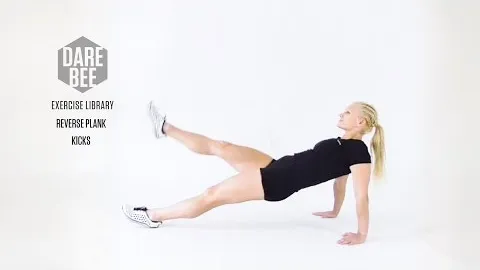
Reverse Plank Kick is a highly effective exercise that targets and strengthens the core muscles while also engaging the lower body. This dynamic movement not only helps tone and sculpt your abs, but it also improves balance, stability, and overall body strength. In this article, we will dive deeper into the benefits, proper form, and variations of the Reverse Plank Kick exercise.
Core Strength: The Reverse Plank Kick primarily targets the muscles of your core, including the rectus abdominis, obliques, and transverse abdominis. By engaging these muscles, you can develop a stronger and more stable core, reducing the risk of lower back pain and improving posture.
Lower Body Toning: This exercise also engages muscles in your lower body, such as the glutes, hamstrings, and quads. By adding a kicking motion to the traditional reverse plank, you can improve the strength and definition of your leg muscles, resulting in a leaner and more toned lower body.
Improved Balance and Stability: Reverse Plank Kick challenges your balance and stability by requiring you to hold a static position while performing dynamic movements. By consistently incorporating this exercise into your routine, you can enhance your proprioception and body awareness, which can be beneficial in other activities or sports.
Increased Flexibility: Regularly performing the Reverse Plank Kick can improve the flexibility and mobility of your back, shoulders, and hips. This exercise stretches the pectoral muscles, anterior deltoids, and hip flexors, helping to alleviate muscle tightness and improve overall movement.
Functional Strength: The Reverse Plank Kick not only helps you develop strength and stability in gym settings but also carries over to your daily activities. By strengthening your core and lower body, you can perform everyday tasks more efficiently and with less risk of injury.
To reap the full benefits of the Reverse Plank Kick exercise and prevent injuries, it is crucial to maintain the correct form and technique. Follow these steps to ensure proper execution:
Starting Position: Sit on the floor with your legs extended in front of you. Place your hands on the floor directly beneath your shoulders, fingers pointing towards your feet. Keep your arms straight and engage your core by pressing your palms and heels firmly into the ground.
Lift Your Hips: Press through your hands and heels to lift your hips off the ground, forming a straight line with your body from head to heels. Engage your core, squeeze your glutes, and keep your legs pressed closely together.
Execute the Kick: From the reverse plank position, bend your right knee and kick your leg out in front of you as high as possible without compromising form. Extend your leg out straight and then bring it back to the starting position. Repeat the same movement with your left leg. Aim for 10-12 repetitions per leg.
Maintain Proper Alignment: Throughout the exercise, be mindful of maintaining a straight line with your body. Your neck, spine, and legs should remain in one alignment. Avoid overarching or sagging your back, as this can put excessive strain on your lumbar spine.
To keep your workouts challenging and avoid plateaus, you can incorporate different variations of the Reverse Plank Kick exercise into your routine. Here are two variations you can try:
Weighted Reverse Plank Kick: Once you have mastered the basic reverse plank kick, you can add an additional challenge by placing a weight plate on your hips. This increases the resistance and intensifies the workout, making your muscles work harder.
Resistance Band Reverse Plank Kick: Using a resistance band can further activate your glutes and hamstrings during the kicking motion. Secure the resistance band around your feet and hold the ends in your hands. As you execute the kick, the resistance from the band will enhance the engagement of your lower body muscles.
Incorporating the Reverse Plank Kick into your fitness routine can help you develop a stronger core, toner lower body, and improved balance. Remember to maintain proper form and gradually increase the intensity as you progress. By combining variety and consistency, you can maximize the benefits of this dynamic core exercise. Start incorporating the Reverse Plank Kick into your workouts today and experience the positive impact it can have on your overall strength and fitness.
If you're looking for a gym, fitness club or yoga studio, you've come to the right place.
You can find information about gyms in your area. Browse catalog of gyms and find gyms with classes which are you looking for.
On gym page you can find simple information like address, phone or website. You can find list of available classes. You can check availability of personal training or small group classes. On place page you can also see information about open hours.
You can find gyms near you with amenities, courts, studios and equipments.
Use our map to find gym at your city or district.
In Gym Navigator you can find list of exercises with movies for many body parts.
You can browse exercises catalog and find exercises the best of you.
You can also find exercises grouped into workout plans, which you can use to improve you body. Each routine show you exercises one by one and give you possibility to count you progress and count down rest time.